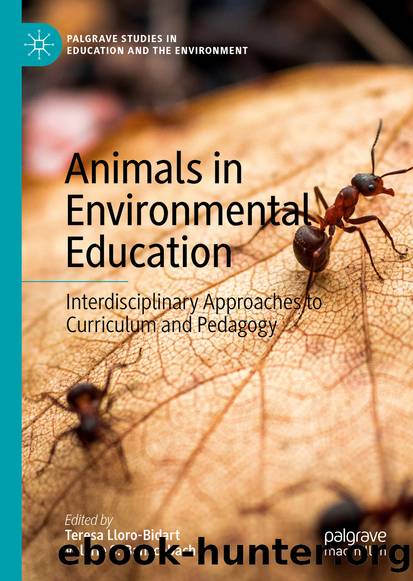Animals in Environmental Education by Unknown

Author:Unknown
Language: eng
Format: epub
ISBN: 9783319984797
Publisher: Springer International Publishing
A Spectrum of Other-than-Human Animalsâ Pedagogical Participation
Interspecies encounters are often framed within educational contexts in ways that explicitly and implicitly depict of animals âasâ educators or teachers. This impulse to describe nonhuman animals as teachers, whether in reference to lessons learned from animals en masse or from individual human-animal relationships or encounters, requires deeper ethical reflection. On the one hand, describing other animals as teachers of humans may actually be a contradictory and even problematic representation of interspecies experience . On the other hand, opening ourselves perceptually and epistemically to the possibility of nonhuman beings as educators furthers a growing, posthumanist desire to decenter the human or challenge deeply entrenched, Western anthropocentrism . It is critical to reflect on these various possibilities for thinking about and representing nonhuman animals as participants in pedagogical relationships, as well as the very real ethical and epistemic implications that result from the lived experiences themselves.
Given the growing number of publications in environmental education and elsewhere that consider âthe question of the animalâ (Oakley et al., 2011; Spannring, 2017), it is useful to develop a heuristic scale for identifying both scholarly and practical work along a spectrum of representation and engagement with other animals as subjects in pedagogical relationships with humans. Such a scale might be relevant for thinking through questions regarding the educational possibilities and values of embodied encounters across species lines. Such a heuristic could provide first steps toward illuminating not only nonhuman animalsâ active participation or subjective contributions within educational projects, but also perhaps the ethical and epistemic value of the relationships being described or employed. I am generally outlining scholarly work on a scale of shallow views or relationships of animals in educational contexts to deeper, more inclusive relations. I provide a few key points that help to situate scholarly work, curricula, goals, or strategies along this spectrum of relationality . These intersecting points and their corresponding questions have to do with representation of animals, assumed or inferred intentionality of other species or beings, and the possible subjectivity or agency of participants in these relationships. Answering each question separately may help us identify the location of a particular work or pedagogical relationship along the heuristic spectrum. Do the human authors or educators utilize language that considers animals as equal participants, agents, or subjects in educational endeavors (representation)? Do scholars consider other animals to be âeducatorsâ themselves and what might that entail (intentionality)? Are researchers interested primarily in thinking of animals as objects or tools within an educational environment, which help learners, but perhaps in a largely passive manner (subjectivity and agency)? What other possibilities for pedagogical interactions exist between species? I suggest that such a framework may help us begin to think through more ethically appropriate ways of engaging with other animals, learning from or about them, and even how to more accurately understand the animal side of the pedagogical picture.
Along the spectrum of possibilities, the dissection of other animalsâ bodies is perhaps an extreme example of what I am referring to as a âshallowâ view of animalsâ participation within education.
Download
This site does not store any files on its server. We only index and link to content provided by other sites. Please contact the content providers to delete copyright contents if any and email us, we'll remove relevant links or contents immediately.
| Automotive | Engineering |
| Transportation |
Whiskies Galore by Ian Buxton(41878)
Introduction to Aircraft Design (Cambridge Aerospace Series) by John P. Fielding(33064)
Small Unmanned Fixed-wing Aircraft Design by Andrew J. Keane Andras Sobester James P. Scanlan & András Sóbester & James P. Scanlan(32743)
Craft Beer for the Homebrewer by Michael Agnew(18140)
Turbulence by E. J. Noyes(7935)
The Complete Stick Figure Physics Tutorials by Allen Sarah(7307)
Kaplan MCAT General Chemistry Review by Kaplan(6866)
The Thirst by Nesbo Jo(6826)
Bad Blood by John Carreyrou(6552)
Modelling of Convective Heat and Mass Transfer in Rotating Flows by Igor V. Shevchuk(6391)
Learning SQL by Alan Beaulieu(6209)
Weapons of Math Destruction by Cathy O'Neil(6142)
Man-made Catastrophes and Risk Information Concealment by Dmitry Chernov & Didier Sornette(5921)
Digital Minimalism by Cal Newport;(5663)
Life 3.0: Being Human in the Age of Artificial Intelligence by Tegmark Max(5474)
iGen by Jean M. Twenge(5366)
Secrets of Antigravity Propulsion: Tesla, UFOs, and Classified Aerospace Technology by Ph.D. Paul A. Laviolette(5309)
Design of Trajectory Optimization Approach for Space Maneuver Vehicle Skip Entry Problems by Runqi Chai & Al Savvaris & Antonios Tsourdos & Senchun Chai(5011)
Pale Blue Dot by Carl Sagan(4909)
